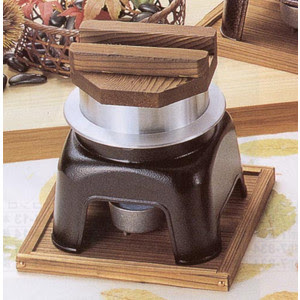Thursday, February 15, 2024
Shad Roe from South Carolina 南キャロライナからのシャド魚卵
You can see the grain of the roe on the cut surface (picture #2). This is much coarser than “tarako” たらこ cod roe or “kazunoko” 数の子 herring roe. The texture and flavor are difficult to describe but we like it. To me this reminded me of the roe of a Japanese fish called “Hatahata” ハタハタ but the Japanese fish has a different texture (a bit slippery texture).
We cooked exactly the same as before (in the previous post) but I did not finish it in the oven. I repeat this again for my convenience.
Ingredients: (small servings for two of us, this will be one serving for most)
One sac (half of one set, picture #3 g one set, came fresh and vacuum packed ) of shad roe, removing attached vessels etc but keep membrane intact
2 strips of bacon
6 florets of blanched broccoli (optional)
Salt and pepper
Directions:
Fry the bacon until crispy and fat rendered, remove the bacon and set aside on paper towel lined plate leaving the bacon drippings in the pan.
Add the shad roe and adjust the flame to medium.
After one side is browned (5 minutes) turn it over cook for another 5 minutes (picture #4). Place the lid and cook 5-10 minutes until fully cooked (no pink inside)
Add the broccoli 5 minutes before the roe is finished and season with salt and pepper
Season it with salt and pepper
I cut into short segments and served.
This was not bad at all. I served it with sides of the broccoli and hen of woods mushrooms which went well. I will try cooking it Japanese style to see how that works. I have to say shad roe fits seamlessly into my Japanese fish roe palette…also, I have to appreciate that my wife’s Grandad was a man of fine taste.
Monday, March 21, 2022
Bluefin tuna chunks 黒鮪チャンク
Recently while browsing online purveyors of sashimi-grade tuna I noticed advertisements for bluefin sashimi tuna "imperfect cuts" or " chunks". I surmise this may be something to do with increased popularity of "poke" which, unlike Japanese sashimi, does not require uniform sized blocks of fish. Since I myself make dishes such as "imitation negitoro" 擬制ネギトロ, and "namerou", which do not require perfect cuts, I decided to try it. This one came from our old, tried and true Catalina Offshore products. As you can see in the picture below, there are several chunks of frozen bluefin tuna. The majority is “akami” red meat and some are “chu-toro” medium fatty. I divided the shipment into three portions. I thawed one in the refrigerator and vacuum packed the other two and put them in the freezer. Since they are chunks, it is very easy to apportion whatever amount I would like to thaw and prepare.
Sunday, June 6, 2021
Raised Buckwheat Blini cooked in a “platar”
Ingredients:
For Blini (makes about 21 blini)
1 1/2 cup milk
4 Tbs. (1/2 stick) butter
2 tsp. yeast
2/3 cup AP flour
2/3 cup buckwheat flour
2 Tbs. sugar
1 tsp. salt
3 large eggs, lightly beaten
For Blini (recipe X2) (mix in the 6 cup pyrex mixing cup so the batter can be poured rather than scooped into the cooking cups.)
3 cup milk
4 tsp. yeast
1 1/3 cup AP flour
1 1/3 cup buckwheat flour
4 Tbs. sugar
2 tsp. salt
6 large eggs, lightly beaten
For topping (everything is to taste and depends on the number of pancakes being served. Also anything can be used. This is just what we came up with.)
sour cream (to taste)
2 eggs, scrambled
1 Tbs. Ikura (salmon eggs) or caviar
Chives finely chopped
Directions:
For the Blini: Melt the butter in the milk. Let it cool to about 105 to 115 degrees. Mix the dry ingredients (yeast through salt) in another bowl. Pour the cooled milk mixture over the dry ingredients mixing until just combined. Cover the bowl with plastic wrap and let it rise in a warm place until doubled in volume (about 1 hour) (#1 in the 3rd group of pictures). Once it has risen either make the pancakes immediately or refridgerate covered for up to 24 hours. (We made the batter after dinner and refridgerated it over night). If refridgerated let it stand at room temperature for 20 minutes (#2). Then deflate the batter and whisk in the eggs lightly beaten.
Now, I am providing the details of how I cooked blini in the platar. This is for our future reference because this requires some finesse. First, I took out the planar and washed it with hot water (no soap), dried it by heating it on the stove and coated each of the 7 wells with olive oil using a paper towel (#3). I preheated the pan on low flame for 5 minutes then used a small ladle (second smallest ice cream scoop) add the batter, half filling the wells (#4). I continued to cook until the surface of the pancake showed bubbles and looked dry (5-7 minutes). Then came the challenge of flipping them. According to my wife, the directions in the JOC said flip the pancakes over using a skewer. But that proved entirely too simplistic. After some experimentation I came up with a method of loosening the blini by running the tip of a dinner knife around the perimeter of the well, then inserting the knife tip under the bottom of the blini to pry it loose. Then with the knife under the blini and a bamboo skewer inserted into the top I flipped it (#5). As I repeated the process I got better and could flip the pancake without damaging the side. But I noticed that the 6 wells surrounding the center well had uneven heat and only the outer half got browned (#5). So with the next batch, I released the blini before they were ready to flip and turned them180 degrees in the well then cooked them for a few more minutes before flipping them over. In the next batch, the first side was more evenly browned (#6). In any case, when all was said and done, we had at least a few perfect blinis (#7= top and #8=bottom).
This is the height of decadence. The blini had a soft thick texture and a very pleasing robust rustic flavor from the combination of buckwheat flour and yeast. The sour cream, eggs and salmon caviar were an excellent combination with complementary creamy texture. The burst of saltiness from the ikura at the end of the bite was a perfect finale. This is how we will be making blini in the future. Next stop crumpets in the platar.
Sunday, December 31, 2017
Caviar and blinis キャビアとビリニ
Certainly, the combination of caviar, blinis, sour cream and chive was perfect. We did not have a particularly special champagne and opened Champagne Philippe Prié Brut Tradition which was pretty good.
The below was the entire setup. We even took out our caviar server (on the lower left).
This is the 1 oz (30grams) we got.
The blinis were good but a bit denser than we expected.
Ingredients:
3 cup milk, warm to 110 degrees
1 tablespoon butter, at room temperature
2 egg yolks, beaten
3 cup all-purpose flour
1 cup buckwheat flour
1 teaspoon salt
2 egg whites, at room temperature and beaten until stiff
1/4 cup butter, for cooking
Directions:
In a bowl dissolve the yeast in the milk. Stir in the butter. Cover and allow to sit for 10 minutes.
Stir in the egg yolks.
Sift together the flours and salt. Slowly stir into the yeast mixture. Mix well.
Fold in the egg whites and mix thoroughly. If necessary add some more milk to get the right "pancake" consistency.
Preheat griddle over medium heat and melt some of the butter. Drop the batter, a tablespoon at a time onto the griddle a couple of inches apart. Cook until the cakes are lightly golden on both sides, about 1 1/2 minutes on each side. Repeat until all the butter and batter are used up. Drain the cakes on paper towels. Sprinkle with the salt and serve warm with caviar and creme fraiche.
As a special treat this was very good. Next time we may add more milk as necessary to get a thinner consistency. Its astounding how fast 1 oz of caviar can disappear!
Saturday, August 16, 2014
Kelp caviar 昆布キャビア

This kelp caviar came in a 3.5 oz glass jar. This is said to emulate the appearance and taste of sturgeon caviar.
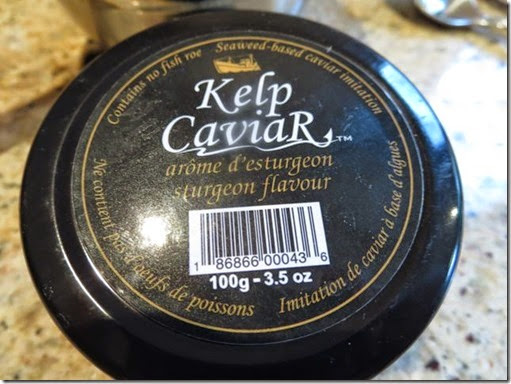
When I opened it, I noticed it had more liquid than real caviar or the previous vegetarian caviar we had.
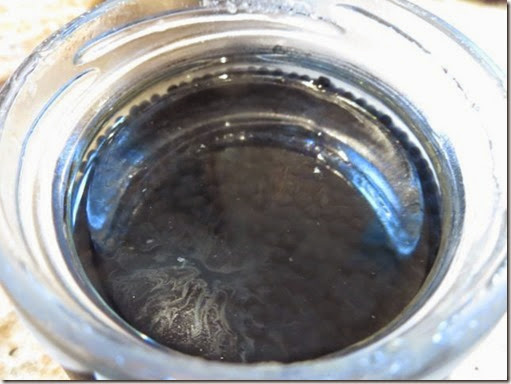
I drained the kelp caviar in a fine meshed strainer as seen below. After which it looked more like sturgeon caviar. By itself, it tasted like kelp (of course this is made of kelp) and lacked the good "pop" mouth feel of real caviar.
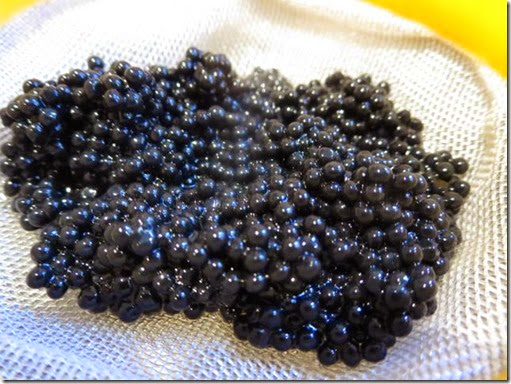
However, when this was placed on top of the blini with creme fraiche (see the first picture), the kelp caviar tasted more like real caviar. This was certainly not bad for fake caviar and will be very handy if you have vegetarian guests. Apparently other vegetarian caviar products are also available. Although we must say we prefer real fish eggs and caviar, these vegetarian caviars are cheaper, available year round, keep longer, and taste better than you think. I got the idea for a future dish; serving salted kelp 塩昆布 on blini and creme fraiche which may taste similar to caviar although the texture maybe off.
Tuesday, May 6, 2014
Decadent breakfast with caviar, scrambled egg and creme fraiche キャビアと卵の豪華版朝食
This is American sturgeon. According to the fine caviar web site;
"Hackleback Sturgeon - (Scaphiryhnchus platoryhnchus) is indigenous to the Missouri and Mississippi River systems"

So this one is from wild-caught sturgeon. As you can see the grain of the caviar is fine and the color is black. The flavor is very subtle but not fishy with a nice salinity. The crunch and pop are great.
This is imported Beluga caviar which appears to come from "farm raised" sturgeons in "Eastern Asia" (which ever country that may be). Again quoting form the website;
"The eggs of the Huso Dauricus Sturgeon are raised in advanced farms located in Eastern Asia."

As you can see the grain of the caviar is much larger and the color is gray. In terms of the flavor, the difference is very subtle. We are not sophisticated enough to say one is better than the other or Beluga is worth the extra expense.

In any case, here is Beluga caviar on blini, with homemade creme fraishe and chives, which was wonderful.

Next morning, we decided to go past just a scrambled egg breakfast. So we put the eggs on blini and added American Sturgeon caviar.

Fish eggs for breakfast may not be everybody's idea of a good breakfast but this combination was quite good and luxurious, at least, to us.
I think we had enough caviar to last us for a while.
Tuesday, March 25, 2014
Savory Japanese egg custard with eggs, eggs, and more eggs ウズラの卵,ウニ,イクラ、カマスの卵のせ茶碗蒸し

The chawanmush was served at room temperature (so as not to “cook” the caviar) and garnished with chopped chive and my usual "real" wasabi.

I made the chawanmushi in the same way as before. I mixed 3 eggs (about 150ml) and 450ml of kelp dashi broth seasoned with light-colored soy sauce or usukuchi shoyu 薄口醤油, salt, and mirin みりん. I poured this through a fine-meshed strainer into individual small bowls. Since I was planning to top it with uni and salmon roe, I did not put in any meat or shrimp but just Ginko nuts (銀杏), (from a can), chopped scallion, and fresh shiitake mushroom (sliced) and boiled quail eggs (ウズラの卵, cut in half, from a can) as seen below.

The amount of egg mixture made 6 small containers (actually soba dipping cups). I steamed them rather slowly using an electric wok for 30 minutes until the custard was set. I removed them from the steamer covered them loosely with a paper towel, and let them cool to room temperature. Except for the two we planned to eat in a few hours, I covered the rest with plastic wrap and move them to the refrigerator for future enjoyment.

This is just a variation on the theme of chawanmushi. The uni was not one of the best (Catalina only had "Premium" but "Gold" is the best). Although the flavor of the uni was good, the consistency was much softer and it had slightly slimy texture. Nonetheless the dish was adequately decadent. It was very good. We mixed up all the eggs and the egg custard and enjoyed the symphony of eggs.
Saturday, March 22, 2014
American Sturgeon caviar and homemade Creme Fraiche アメリカ産のキャビアと自家製クレムフレッシュ

The above tin is 2oz (57grams) of American sturgeon caviar from "Fine caviar". Compared to what I previously got from Catalina Offshore products (0.35oz or 10grams!!), the price for 2oz tin is nearly identical to the 0.35oz tin and the quality is equally as good (at least to us). Keep in mind the amount is almost 6 times more for about the same price! This is indeed a good size tin for the two of us to enjoy some caviar. We defrosted several of the blinis we made before and enjoyed the caviar with home-made creme fraiche. Previously we could not get creme fraiche* so we substituted sour cream*. This time we were not going to let a small obstacle such as no creme fraiche at the grocery store stop us. So we made our own(see below). We also added chopped chives as garnish. Finally, we could sit down and savor the joy of caviar to its fullest extent—mission accomplished.

Since we were ordering the caviar, we also got "Golden Pike" caviar.

To be honest, we prefer Japanese "Tobiko" トビコ or "Masago" まさご roe (flying fish and capelin roe, respectively) over this golden pike roe. This roe has a slight slimy texture and not much flavor bedside some fishiness.
We also got "Ikura" イクラ (salmon roe) in a small jar from the same source but it looked slightly cloudy. Again we prefer the Japanese-style ikura we get from Catalina or the Japanese grocery store.
*Creme fraiche vs sour cream:
We like creme fraiche over sour cream (both are commercial products) because the creme fraiche has a more delicate taste and better texture. We thought creme fraiche and sour cream both were heavy cream with lactobacillus fermentation and did not know the difference. It appears that commercially-made sour cream may not be "fermented" at all but made with the addition of thickening agents and acids to heavy cream. We also learned that when adding to a sauce, sour cream breaks easily but creme fraiche does not. We have yet to test this statement in practice.
In any case, we knew it was supposedly easy to make creme fraiche at home and discovered that it was indeed easy.
How to make creme fraiche or (home-made or real) sour cream:
We added buttermilk (2 tbs) to cream (1 cup) and let it sit on the counter at room temperature for 1-2 days in a loosely covered sealable container (the time will depend on the temperature—it was fairly cold when we made it). After the desired thickness was reached, mix well, seal the container and refrigerate. That is it. We tried it with "light" (fat 18-30%) cream as well as "Heavy whipping" (fat 36%) cream. Both worked well but we probably liked the one made with light cream because it had a lighter taste and mouth feel. Instead of buttermilk, we could have used yogurt. But we have not tried that method yet. Our homemade creme fraiche is very good--better than the creme fraiche or sour cream we bought at the store. Come to think of it after this we won’t be buying any more at the store.
Wednesday, March 19, 2014
Blini with sour cream and scrambled eggs

We just layered the blinis with sour cream and then soft scrambled egg, sprinkled some salt and garnished with young shoots of Italian parsley we are growing on the window sill.
With scrambled eggs, the flavor combination is quite different. It is, nonetheless, a perfect breakfast which goes well with our first cup of cappuccino made with our home expresso machine (We do also roast green coffee beans at home).

Sunday, March 16, 2014
Blini with sour cream and olive ビリニのサワークリムとオリーブ乗せ
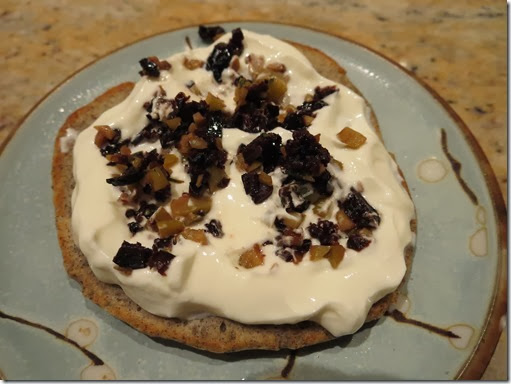
I simply chopped up a mixture of green and black oil cured olives after removing the stones. As we did with the caviar, we heated up the blini and let it cool a little to prevent the sour cream from melting. Then I layered the sour cream (creme fraiche would have been better. Home-made creme fraiche is for another post) and added the olives.
This turned out to be really good. If it is not exactly like real caviar it is at least reminiscent of it. The saltiness and flavor of the olives really goes well with the blini and sour cream. We tried this with sake and it went remarkably well.
*Many years ago, a company in Glendale, CA made vegetarian caviar (from seaweed, I think) and we got it a few times but the company went out of business. I have seen "vegetarian" caviar advertised on some caviar selling websites. It appears to be same or a very similar item. We may try this in the near future.
Thursday, March 13, 2014
Caviar on Blini キャビアとビリニパンケーキ
To make the caviar experience authentic, we served the caviar with sour cream on blini pancakes which we made for the occasion.
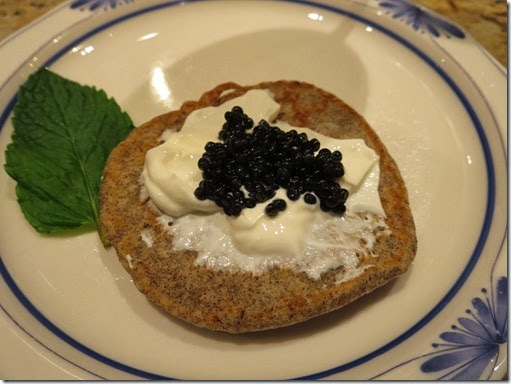
At one time, in the past, we were curious to find out what all the hype was about caviar. So we had several caviar tasting parties with our good friends to try different kinds. As a legacy of those good times we had the special caviar serving dish shown below. It was given to us by our fellow tasters and was quietly tarnishing in the cupboard since it has been quite some time since we used it. My wife found it, polished it up and used it to serve the caviar.
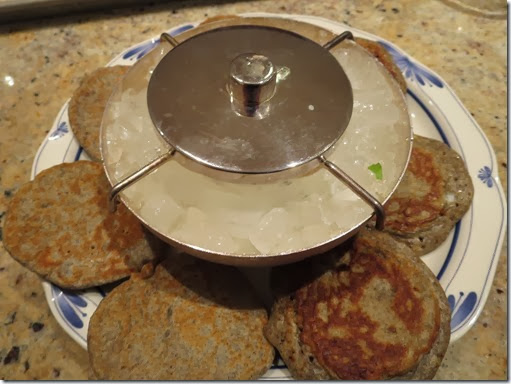
As you can see in the picture, unfortunately, the amount of the caviar was ridiculously minuscule. Yes, the entire contents of the package are on display there at the bottom of the serving dish. I should have checked the specifications more carefully. I don’t know what I expected (probably something closer to an ounce) but it certainly not just the 10 grams (0.35oz) we received. This is by far the smallest tin of caviar I have ever seen. For a similar or slightly higher price per unit, we could have gotten genuine Russian Beluga.
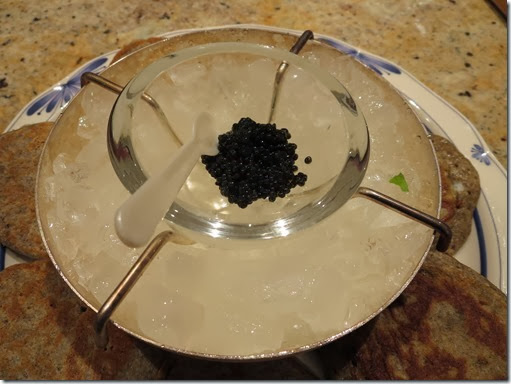
In any case, to make the blini, I followed the recipe by Emeril Lagasse. I am familiar with the method of using both yeast and baking powder to leaven bread but his recipe used yeast and then whipped egg whites. As usual, my wife made the batter following the recipe and I cooked the pancakes (with my left hand since I was still recovering from my surgery on my right hand).
Batter:
1 package (1/4-ounce) dry active yeast
3 cups milk, warm to 110 degrees F
The only modification we made to the original recipe was to let the dry yeast proof. We did this by adding it to a small amount of warm (110F) water with a pinch of sugar, letting it stand undisturbed for 10 minutes to make sure it was vigorously bubbling. Then we added the mixture to the milk and butter mixture, mixed in the egg yolks, flour, and folded in the stiff-peak whipped egg whites. I checked the consistency and added more water to make the batter loose enough to spread as shown below into just over 2 inch pancakes. (I found that I usually have to adjust the consistency of pancake batter to get it right, regardless of the recipe I use).
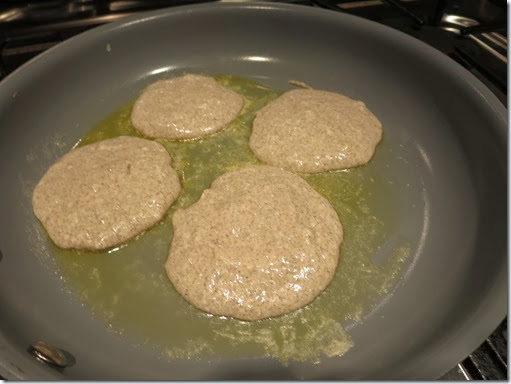
After 1 to 1 and half minutes on medium low heat, I flipped the pancakes and cooked them for another minute.
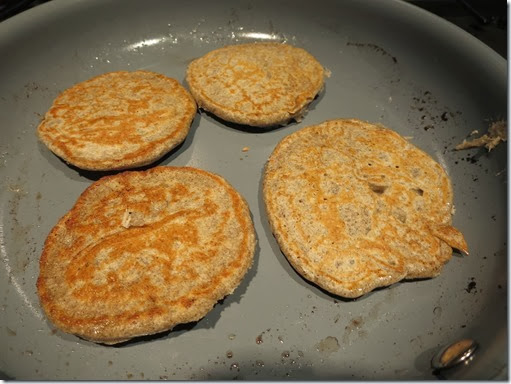
For libation, we opened a good California sparkling wine Mumm Napa "DVX" 2001. This is a good clear sparkling wine with some depth; green apple, melon and hint of yeast or bread-like flavor and fine bubbles. (The other picture shows the caviar package).
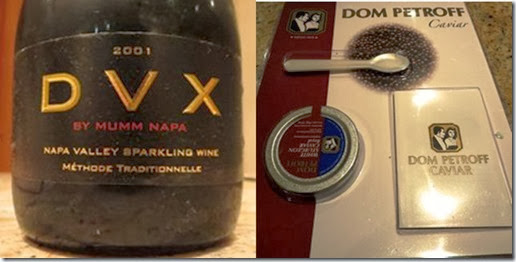
Although the taste of the American sturgeon caviar was very good and went perfectly with the blini, sour cream and the sparkling wine, it was a cruel tease. There was only enough for 4 very small servings if we stretched it. That was just enough to ignite our dormant appetite for caviar. My wife immediately pronounced that we had to go get some more. Since the blini batter made close to 3 dozen pancakes foraging for more caviar seems justified. The additional supplies, however, will have to come from some other source.
Friday, July 5, 2013
New York Izakaya-style restaurants ニューヨークの居酒屋風レストラン
This is by no means a restaurant review but more a record for ourselves of the great time we had. Although I took a camera, I did not take any pictures. Somehow, as the meal unfolds and I immerse myself in the enjoyment of the food and drink the idea of taking a picture of the experience becomes distracting and falls by the wayside (even though that doesn’t seem to be the case with the other people snapping pics to the right and left of us). I am sure most of those pictures are destined for Facebook and Instagram to "share" the experience with friends). So all the pictures shown here are either from Google street views (all the outside pics) and from the corresponding websites of the restaurants.
1. Aburiya kinosuke 炙り屋錦乃助
The picture below shows the outside of Aburiya. It is the left entrance of the building with the vertical stripes of green, blue, yellow and red. Despite the bright colors visible in this picture there is not much signage indicating the location of the restaurant except a demure blue "Noren" at the entrance. It was a 20 minute walk from our hotel to the restaurant. I was navigating using Google maps on my iPhone and I knew exactly where we were and where the restaurant was supposed to be located. But we couldn’t find it. We walked back and forth on the block several times but we could not see anything that looked like an Izakaya or Japanese restaurant. We saw the Wyndham Hotel (below left). Was the restaurant located in the hotel? I ended up calling the restaurant. The manager first tried to explain that the entrance was to the right of the Wyndam. There was in fact a restaurant on the right side of the Wyndham but it was definitely not an izakaya. Finally the manager said "just wait there". He came out to the sidewalk found us literally standing in front of the restaurant and ushered us in. How embarrassing.

Inside is surprisingly large (deep). The front of the restaurant had tables and, in the back, (going down few steps) there was a L-shaped counter which can seat about 10 or more people. Inside the counter, there was a grill and 3 young chefs in Aburiya T-shirts busy at work. On the left side along the wall were a few shelves on which 10 or so individual "Kamameshi" 釜飯 vessels were placed. (see below, this pic is from http://store.shopping.yahoo.co.jp/kappabashi/m10-230.html).
We noticed that occasionally flames appeared under some of the "kama" vessels. This must be how they cook the individual "Kamameshi". We were advised that if we wanted Kamameshi it would take about 40 minutes so get the order in early. We were seated at the counter in front of the "sashimi" station or #1 and 2. (I specifically asked for counter seating). The chef was busy cleaning and removing the fillets from whole fish which was a good sign. I tried to engage him in conversation but he was too busy. Another chef was in charge of grilling and yet another serving up other dishes.
We started with two cold sake "Uragasumi" 浦霞 (junmai) and "Kokuryu" 黒龍 (Ginjou). They brought us a wooden box with ice in the bottom and two empty sake carafes (Probably Bizenware 備前焼 or imitation thereof—very nice). Then, they brought up the sake bottles, showed us the labels and then poured into the carafes. A very nice touch assuring us we were actually getting the sake we ordered.
We started with the sashimi three kinds (which were salmon, kampachi and flounder). The sashimi was good (although the salmon was the best sashimi which tells me that tuna and other good sashimi fish must be difficult to get or too expensive). One thing that struck us as different was the use of an artificial-appearing transparent thready thing made of agar-like material* (hope this is not plastic since I ate some of it) instead of the usual daikon "tsuma" 大根のつま garnish. We’d rather not to have any garnish than this stuff.
P.S. Later I came across this item on the Web. It is called "Kaisou-men" 海藻麺 or "Kaisou vidro" 海藻ビードロ (Vidro means "glass" in Portuguese) and made from sea weed.

Although the details of what we ate escapes me a bit, we had "smoked daikon pickles or "Iburi gakko" いぶりがっこ, homemade tofu with three different flavored salts (above picture on the right), firefly squid "okizuke" ホタルイカの沖漬け (excellent!), Tuna "nakaochi" yukke (鮪の中落ちユッケ, tuna tartar Korean style) with a porched egg or "onsen" tamago 温泉卵. This was in good quantity and tasted good. We had few more items such as pork belly "kakuni" 角煮 (we could not pass up this item, good size and melt-in-your-mouth excellent with honey-flavor). We had more sake (Dassai 獺祭50) and some more food. We were too full for any rice dish to end the evening.
This is not an authentic robatakayaki or Izakaya but it is a very nice drinking place to visit and reminds me of some high-end chain Izakayas in Japan. The counter area, at times, got sort of smoky adding to the atmosphere. There was plenty of hustle and bustle that again added nicely to the atmosphere. It was a great place to “people watch”.
Information on Aburiya Kinosuke
213 E 45th St, New York, NY 10017
212-867-5454
Aburyakinosuke.com
2. Saka mai 酒舞
Since I could not get a reservation at Sakagura, I chose this place. The name "SakaMai" usually means rice specifically grown for making sake or 酒米 but they attached the ideograms 酒舞 meaning "sake" and "dance". It is on the lower east side in an area that apparently used to be a residential with old town houses lining the side streets. The restaurant was a renovated old town house (there was apparently another restaurant at this location previously as you can see in the Google street view below). The best way to direct a taxi cab to the restaurant is to say "Please take us to Katz's delicatessen at E Houston and Ludlow. The cab dropped us off in front of the delicatessen and we worked our way through the crowd of tourists standing out front taking pictures. It was a short one and half block walk from Katz's to SakaMai. The restaurant has been in business for about 6 months according to the Japanese bartender (or mixologist as he preferred to be called) who spoke with a Japanese-British accents (spent 7 years in London) . By the way, the lot next to the SakaMai was still empty as shown in the picture below.

Once inside the restaurant, it is a totally different world from what you may have expected from the streets and exterior. Again it is a large place since it is very deep. The front part had tables and the back had a bar counter as you see below. Nice warm light wood decor. We sat at the counter.

Although we did not come for the cocktails, we decided to take advantage of the expertise of the resident mixologist. The sake based drinks were unique and delicious. My wife had "Haizakura" 灰桜 and I "Sakoudo" 酒人. "Haizakura" is composed of sake, plum wine, salted plum (umeboshi) vinegar and peach liquor. It was interesting and quite good but a bit too sweet for us. "Sakoudo" is a type of "saketini" made with sake, Hendrick's gin, mirin, orange bitters. It has a faint but unmistakable citrus note. I initially thought it had a "yuzu" flavor. I am not sure it is from the Hendrick's gin or orange bitters but must be the latter.
We then had flights (three small glasses each) of "genshu" 原酒 and "daiginjou" 大吟醸. I do not quite remember all the sake we tasted (taking pictures may have helped). One of the "Genshu" was "Kikusui" 菊水一番しぼり which was poured from an aluminum cup (one of the "cup sake") (see picture below). I do not remember the name of other two now.
The daiginjou flight included "Dassai 50" 獺祭, and Hakkaisan 八海山. We like the third diaginjou which I do not recall the name (despite my wife's telling me to remember the name). We had a cup each of daiginjou and genshu. These sake were not bad but none was extraordinary. We wished more information about the sake we tasted was provided to us especially since this is a sake bar.
For food, we started with "Kampachi" crudo. It is a small serving but nicely done. Good quality kampachi sashimi garnished with finely chopped perilla, myouga and wasabi with shoyu graze. Uni crostini was again small and grilling made the delicate flavor of uni to diminish a little. We also had egg-on-egg-on-egg (picture below). This is a very nice creative dish. Instead of a real sea urchin shell seen in the picture below, it was served in a porcelain bowl made to look like a sea urchin shell. The bottom was nice creamy scrambled egg topped with caviar and uni. You cannot go wrong with this combination but it was excellently prepared.The "chawan mushi" 茶碗蒸し was forgettable. The croquette was ordinary and we could not find any lobster meat albeit it was called lobster croquette. We also had grilled dried skate wings and renkon chips. Interestingly, the renkon chips were the only sizable appetizer we had all evening but they were crisp and addictive.

For the ending dish, we each had a pork bun which was very elegantly done. The pork filling was great--a large tender chunk of pork belly. They have a larger dish of steak and mushroom rice to be shared with 2 or three but we were stuffed so it was out of the question for us.
Information on SakaMai
157 Ludlow Street
New York, NY 10002
(646) 590-0684
sakamai.com
3. Torishin 鳥心
The last day, we went for Yakitori. We took a taxi cab. Having learned that traffic is generally bad at any time we took precautions and started early to get to our reservation on time. But, of course, this was one of those rare instances in New York when our taxi sped through the streets without slowing down (even for the stop lights) and we arrive there 30 minutes earlier that the designated time.
The outside was rather un-assuming. Since I did not take any pictures, this is from the Google maps street view (below). Once inside, the interior was quite nice with lots of light colored wood (second pics below which is from their website).

The restaurant was mostly counter seating with a few small tables. Even though it was fairly early the place was basically packed when we arrived (good thing we had a reservation). We sat at the corner of the counter next to the chef tending the grill. The menu is very close to Japanese counter parts especially those of more modern/tame chain yakitori places which have proliferated in Japan (I do not indicate a negative here, it is clean and nice).
They had a special cold sake they recommended. This is supposedly a seasonal special, un-pasteurized or "nama genshu" 生原酒 sake , I think, it was Ichino-kura namagenshu 一の蔵生原酒. There may have been "arabashiri*" 荒走り on the bottle label as well. This was quite good with nice crisp taste and clean fruity notes. Towards the end, we run out of sake and ordered a glass of "Nanbubijin daiginjou" 南部美人. They served us in a glass with a generous spillover into the "masu" ます saucer. Actually, this was the best sake for the evening.
*Arabashiri (meaning "wild runs") is the first portion of sake comes out without any pressure when it was filtered/pressed in the traditional way (not using a modern mechanized press). Supposedly it shows more wild and flavorful sake.

In front of the counter was a cold display case similar to the kinds seen in any sushi bar. Many prepared skewers were displayed inside. There were two grills (or "Yakidai" 焼き台) one near the right corner where we were seated and the other at the opposite corner.They are boasting the use of Japanese lump charcoal called "binchoutan 備長炭 which is known to burn hot. Despite the ventilation system just above the grill some smoke escaped every-now-and-then and added to the ambience but never became too smoky as can sometimes happen in small Yakitori places in Japan.
The vegetable skewers were displayed on the top of the cold case in the bamboo basket (see below, again the pic is from the Torishin website). Interestingly there was small sign in the middle of the basket saying "Display only (in English)". We thought these were fake skewers for display only (like realistic models of dishes seen in many restaurants in Japan) and admired how they looked so real. Then, we noticed the woman chef was taking theses skewers from the basket and giving them to the griller. Apparently these are real vegetable skewers. We have no idea, in that case, the meaning of the sign "Display only".

The yakitori menu is rather standard but rare parts are reserved for the "omakase " course and cannot be ordered as a-la-carte which included two kinds (from kiel and back bone) of "cartilage" 軟骨, neck meat せせり, kidney 背肝 etc. We just went with a-la-carte. the chicken liver 肝 was underdone (I am sure this was what the grill chef intended) which made us a bit uncomfortable since we had to assume they were from US chickens with the possibility of salmonella. (They said they were using "organic" chickens, whatever that means). Skin 雛皮, tail ぽんじり (ponpochi or ponjiri), heart ハツ, and tsukune つくね were good. Fatty pork belly "tontoto" 豚トロ was also good. Chicken thighs 腿 with different sauces, grilled quail eggs ウズラの卵 and ginko nuts 銀杏 were just OK. Chicken wings 手羽 were small but with a nice crispy skin and were great. As a special vegetable, they had a small radish or "ko-kabu" 小蕪 (which was simmered in dashi broth first, then grilled, and served in a small bowl with sweet miso and vinegar sauce. We were not sure if the grilling added anything. The sauce was excellent and my wife detected honey in the sauce. For vegetables (we need the nutritional balance), we ordered assorted "tsukemono" 漬物 which was a bit disappointing especially the cucumber was over pickled and too thinly sliced. I do not remember how many more skewers we ordered but the size of the skewers were quite small compared to those in many Yakitori places in Japan. As a result, we ended up eating quite a few skewers. They also have rice dishes (Donburi 丼 or rice bowl affair) but we were quite full and well-watered at this point. Instead, we went back to our hotel and enjoyed a nice glass of cava at the bar and interesting conversation with the bartender.
Information on Torishin





















